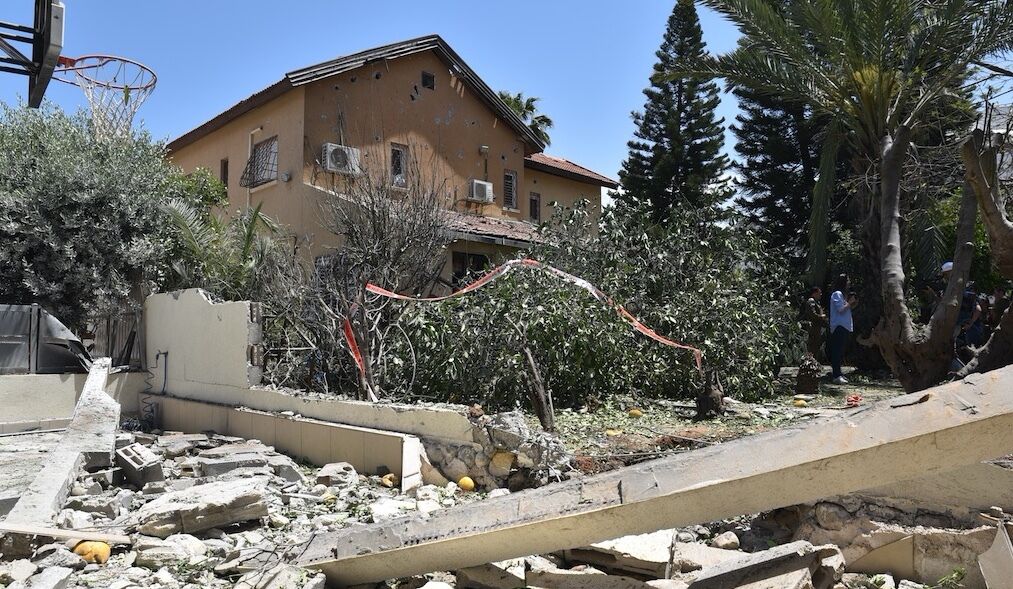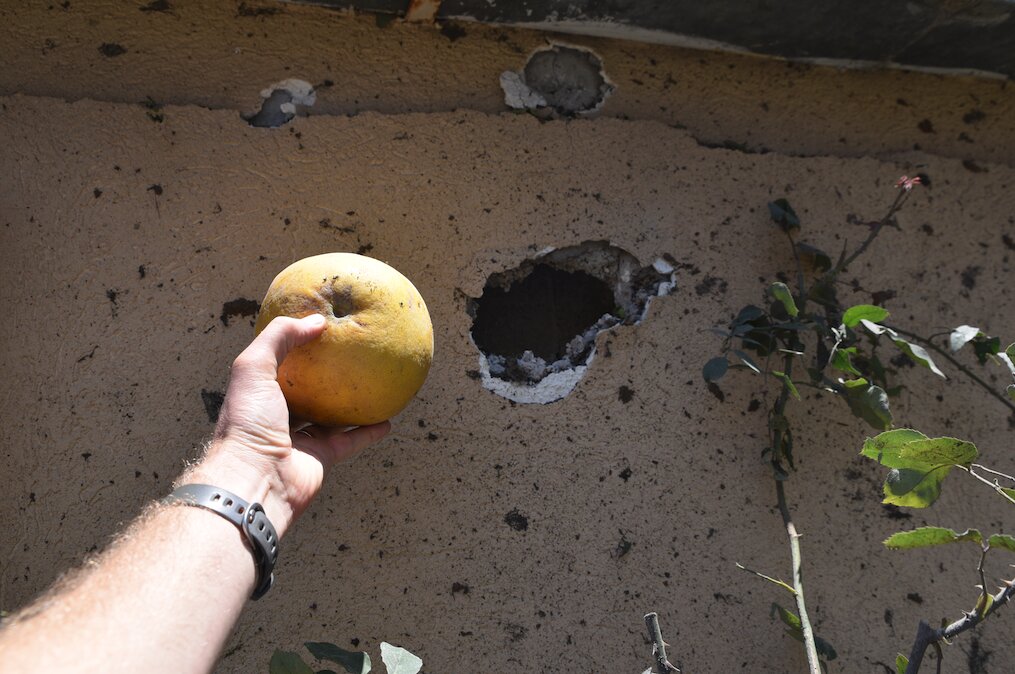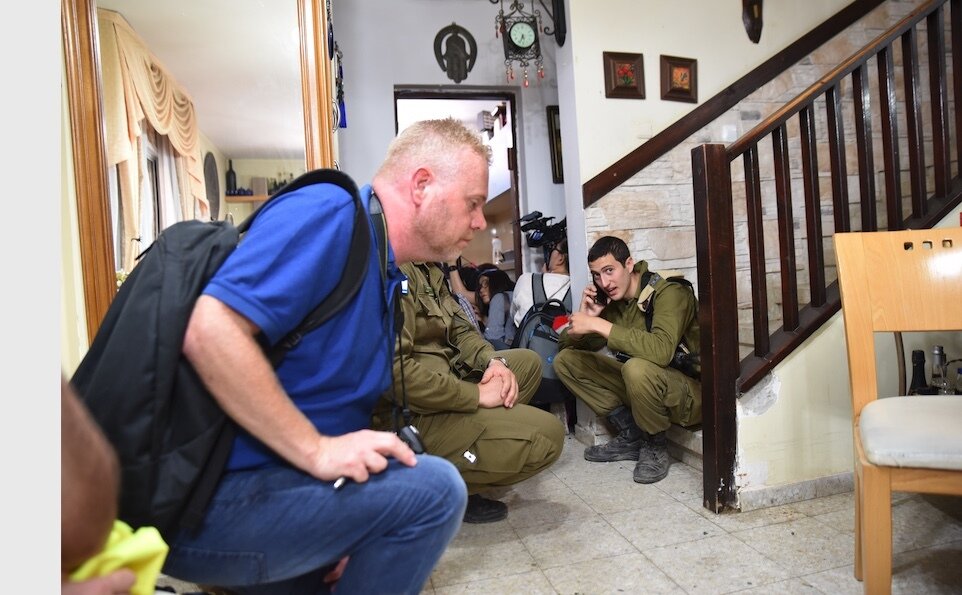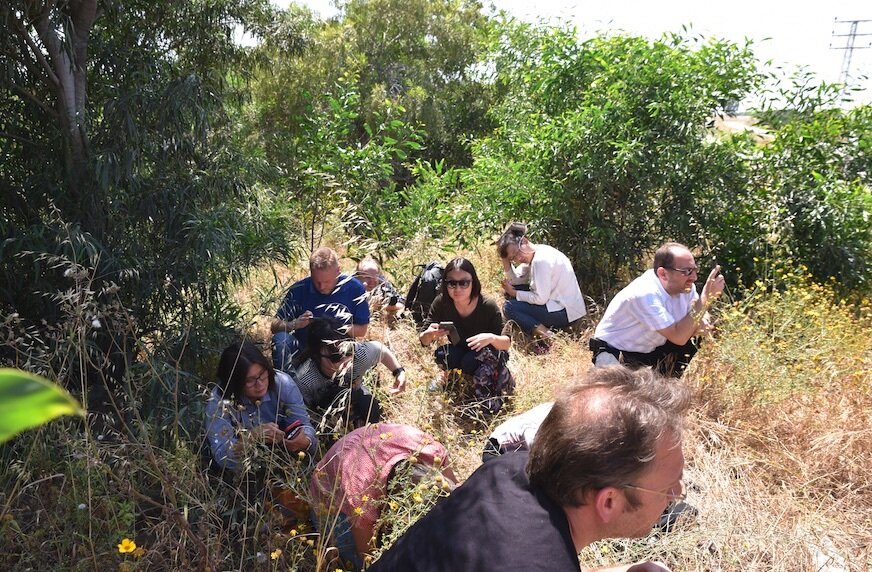
Why Can’t Israel Solve the Gaza Crisis?
jerusalem
Six hundred ninety rockets or mortars were fired from the Gaza Strip in the last two days, marking the most serious uptick of violence in the past four years. Israel’s Iron Dome Aerial Defense System intercepted 240 of them. Most of the others were allowed to fall into open areas. The remaining dozens hit populated centers in the south, killing four civilians and wounding dozens more.
On Sunday, during the heaviest barrage, I visited Ashkelon, a city of 140,000 people and the scene of numerous penetrations through the Iron Dome. As part of a group of journalists organized by Media Central, we first visited the home of Moshe Agadi, who was killed by shrapnel from a rocket the previous night.
Arriving at the property we were told to be quiet out of respect for the grieving family inside the home, whose loved one was killed just 10 hours earlier. A 5-to-6-foot-diameter hole in the yard beside the house marked the impact zone of the rocket, which completely destroyed a concrete wall separating the house from the neighboring property. Agadi’s home, though spared from a direct hit, was scarred with shrapnel holes the size of grapefruits—shrapnel that penetrated the home and killed Moshe, a 58-year-old father of four.

After a press briefing by Israel Defense Forces spokesman Lt. Col. Jonathan Conricus and police spokesman Mickey Rosenfield, we were free to take pictures of the site. Every now and then, one of the family members would poke a head out the door to see if we were still there, obviously finding it hard to deal with the death of a loved one while their residence was crawling with journalists. I assume the family thought it was worth making their grief public if it meant that more in the world would realize the constant threat these Israelis are under.
It didn’t take long before we too got a taste of that threat.
Just as we were preparing to leave, the sirens began to blare over the city. I was standing on the other side of the road from the property at the time. Immediately, I heard the sound of a rocket roaring through the air.
I froze for a second to think of my options. Do I throw myself to the ground? Do I run for shelter? Just as I decided to run back to the house with the others, I saw the Iron Dome’s counter-rocket fly into the air. I didn’t look back to see if it hit. (Listen to the sound of the incoming rockets at 18:30 on the link below)
There we were—journalists, foreign and Israeli, a few idf soldiers, the idf spokesman and the grieving family—all squatting down together on the floor, listening to impacts and interceptions. It might sound cliché, but it felt like the thump of my heart was as loud as the pounding outside.
After the attack ended, we went outside. There was no sign of destruction, although to my unfamiliar ears it seemed like the strike was close.

It wasn’t but two minutes later and another burst of missiles headed toward Ashkelon. This time I looked up and three or four missiles were fired from the Iron Dome to intercept the rockets. Like strands of white ribbons, the Iron Dome’s missiles left perfectly separated vapor trails in the sky before they scattered to hunt their targets.
Again, we were inside, huddled with the Agadi family. Again, shaking our heads in disbelief. We were taking cover in a home where someone had died the previous night from the same type of rocket fire. Thankfully this time, lightning did not strike the same place twice.
Instead of continuing on to our planned meeting with municipality officials, we headed to a nearby concrete factory, just two kilometers away, where one of the rockets had landed.
Arriving at the scene, we saw that an ambulance, a firetruck and police were already dealing with the situation. Standing by the ambulance was a medic I had earlier seen hastily climb into an ambulance while I ran for cover in the Agadi residence. Turns out, he had been heading to the site of the second attack.
Two of the workers were seriously injured by the attack, and at least one of them later died from his wounds. A worker at the factory told Haaretz that he had tried to get one of the workers who was killed to the shelter, but he had chosen to stay outside. “I told him, ‘Come with me, run to the shelter,’ and he said, ‘No, not necessary.’” Considering these attacks happen so frequently, and largely without incident, I can understand the carelessness.
Leaving Ashkelon we boarded the bus once more to visit the small community of Nahal Oz, where a rocket had landed the night before. However, shortly after leaving the factory, the sirens sounded again for an incoming rocket. This time, the driver pulled onto the shoulder, and the 15 or so journalists piled off the bus as quickly as possible. Being last off the bus, I knew my chance of getting down in time was slim. Thankfully this time, the rocket or mortar didn’t come close.

We boarded the bus, but didn’t make it to Nahal Oz. Our trip was called off after a car was hit while traveling down the road we were about to take. It was hit, not by a rocket, but an anti-tank Kornet missile, fired over two miles away from the Gaza Strip. The one man traveling in the car later died from his wounds in hospital. His death brought the total Israeli deaths for the day to four—four more citizens than have died in almost five years on the Gaza border from a rocket.
I’m still processing the events from Sunday, but here are a few takeaways from my visit.
‘Land for Peace’ Does Not Work
When Israel pulled out of the Gaza Strip in 2005, it did so hoping that some sort of peace between Israel and the Palestinians could be accomplished. This did not happen. The Iranian-backed Hamas Palestinian group took control of the territory and embarked upon a decade-long war against Israel, using the territory and funds to launch rockets at civilians, dig tunnels to infiltrate Israel, and kidnap soldiers for future bargaining chips with the State of Israel.
Since that time, there have been three wars, the latest taking place in the summer of 2014. And since then, there have been numerous dangerous flare-ups on the border, similar to this weekend’s. Generally, it is Israel’s concessions that restrain further actions. It’s impossible to have peace with Iranian-backed terrorist groups that are sworn to Israel’s destruction.
The Weakness of Israel’s Gaza Policy
While many outside Israel will laud the current ceasefire as a wonderful achievement, most in Israel don’t—certainly not the 200,000 civilians within range of Hamas’s shorter-range weaponry. After 12 years of failed policy, we know that “mowing the grass” every few years in a war with Hamas is not a sustainable solution. There is an entire generation of Israeli children who know no other life than bomb shelters, code red sirens, and post-traumatic stress.
The rockets are becoming more effective, and Hamas is becoming smarter in how to use them. On Sunday, Hamas and Palestinian Islamic Jihad (pij) employed a mass barrage technique to try and overwhelm the Iron Dome system. And even though the Iron Dome had 86 percent efficiency, many still got through. They are now putting heavier warheads on the rockets, filling them with more life-shredding shrapnel, such as was evident at the Ashkelon residence.
The Iron Dome may be a savior in many respects, but it also prevents Israel from seriously dealing with the problem. Without the Iron Dome, 240 projectiles would have likely hit civilian areas. If that had happened, Israel would be entering full-scale war, which, looking at this humanly, is what it would take to stop the incessant fire.
Iran Is Pushing the Region Toward War
The international media often fail to recognize that this is not a fight between Israel and the Palestinians. Rather, Gaza is just one battlefront in Iran’s war on Israel. As idf spokesman Conricus told us on Sunday, “Iran’s fingerprints are over everything” in Gaza. “There is almost total reliance of the pij on Iranian funding and weapons. Almost all of the mortar’s rockets or weapons fired by the pij were either manufactured in Iran or purchased with Iranian money,” he said.
While these Palestinian factions may sit at a negotiating table to gain concessions from Israel (as was happening when this round of fighting started), it is Iran that tells them when to pull the trigger.
Dominating Hamas and the pij inside the Gaza Strip gives Iran another front from which to threaten Israel. And while most in the media will not portray it as such, the current Hamas-led violence on the Gaza border should be seen as another Iranian battlefront against the Jewish state.
Iran has a potent and passionate desire to eradicate the Jewish state and take control of Jerusalem. Iran continuously meddles in Palestinian affairs to further its own goals. Iran’s ideological, logistical and monetary support of Palestinian terrorists is about nothing less than conquering Jerusalem. For this reason, there can be no peaceful resolution with the Palestinians while they are funded and directed by Iran.
Two decades ago, Trumpet editor in chief Gerald Flurry berated the West for being “spellbound by peace treaties” and thus suffering willful blindness to “Iran’s massive plot to control the Middle East.” Then he wrote, “The most precious jewel of Iran’s plan is to conquer Jerusalem. This would then galvanize the Islamic world behind Iran!” (The King of the South). This latest Gaza flare-up is more proof that Iran has not given up its goal.
No Human Solution to Gaza
Israel is undoubtedly the strongest military power in the Middle East. However, I found that hard to reconcile while I was squatting down next to the idf spokesman for fear of incoming rockets. How much is Israel’s military dominance worth if its people are so often holed up in bunkers or safe rooms in their own houses?
Many Israelis understand the weakness of the current strategy and want to do something about it. Some politicians are now calling for Israel to retake full control of the Gaza Strip. However, Gaza has a population of about 2 million Palestinians, so retaking it would be the easy part—ruling it would be difficult.
As we have often said, there is no human solution to the Gaza crisis.
Mr. Flurry has often noted, as did some of Israel’s own founders, that the modern State of Israel was born and sustained by miracles from God. The victories in 1948 and 1967 are a testament to God’s desire to see the nation of Israel reborn in the land of their forefathers.
In those early days, Israel was weak militarily, yet that was when its greatest victories took place. In terms of military power, those were wars Israel should not have won.
Now that Israel is strong, where are the miraculous victories?
Or even any purely man-made victories for that matter?
There is a cause for 12 years of failed policy in Gaza, as well as the ineffectual Lebanon wars. In many cases, Israel retains a sense of will that is so lacking in other nations in the West. The few times I’ve visited the Gaza border I’ve seen individuals with a refreshing fire in their belly, who were willing to do anything for their country.
Nevertheless, even with its unprecedented strength, Israel is unable to solve its problems.
There is a cause.
If you would like to know the reason for Israel’s failing policy in Gaza, and why it can’t defeat its weaker enemies, I suggest that you read Jerusalem in Prophecy, by Mr. Flurry. Along with exposing the reason for Israel’s military weakness, this booklet also details the times when Israel received miraculous victories from God. More than that, it also forecasts a time when Israel will once again receive the divine help from God that it needs.
